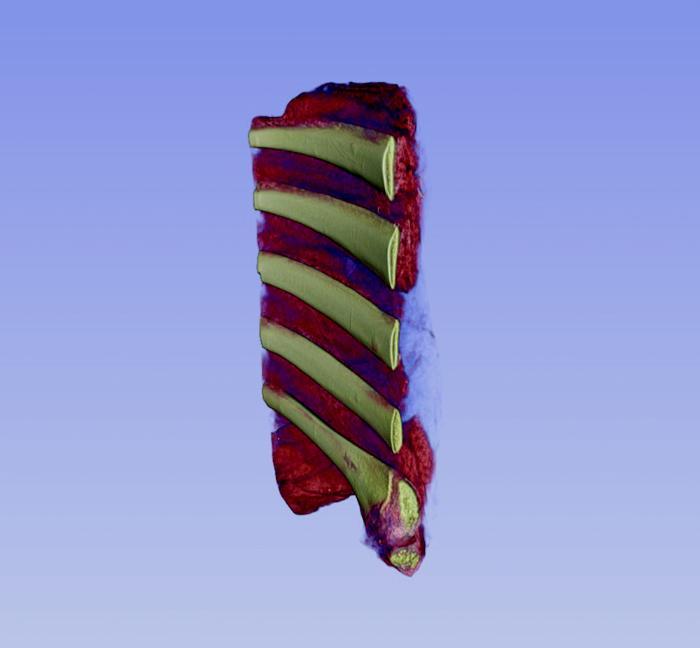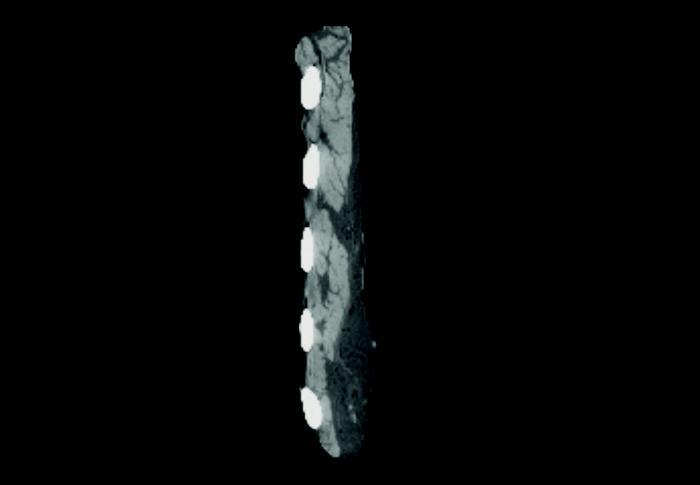19 November 2024
Meat-ing the demand
Uptake of digital tools in the food sector is not yet widespread, but has the potential to transform red meat processing to handle contemporary challenges.

X-ray computed tomography-based reconstruction provides ground truth information on tissue structure in beef rib. Photo credit: Teagasc
Digital tools are increasingly emerging as enabling technologies in the manufacturing sector. The concept of a digitalised manufacturing industry, Industry 4.0 (I4.0), is built on generating and connecting shop-floor data with enterprise. By digitalising and automating aspects of real-time decision-making, companies can streamline their production process, increasing efficiency, productivity and sustainability metrics.
Advances in AI and the handling of large datasets has broadened companies’ capabilities. Digitalisation has transformative potential for food processing, but adoption has generally been slow compared to other industrial sectors. Yet, digital capability is vital in the face of unprecedented population growth, food security issues and the climate crisis.



Promoting uptake
Red meat processing is a significant sector of the Irish agri-food industry, supporting regenerative agriculture and the conversion of marginal land not suitable for crop production for human consumption. However, it is a low-margin enterprise challenged by a lack of skilled labour and the sustainability of its raw materials, explains Ruth Hamill, Principal Research Officer at Teagasc Ashtown.
“Red meat processing throughput is expected to increase by 14% by 2030. Red meat provides a high-quality source of nutrition; increasing demand is a hallmark of the expanding middle class in emerging markets worldwide.”
This increased demand highlights the importance of digitalisation. Key technologies in I4.0 offering transformative potential to the meat sector include AI and data analytics, sensors and computer vision, digital twin and automation.
Despite interest among food companies, data analytics uptake has been slow; hampered by a high proportion of their data not being integrated and – in many cases – not digital. However, data analytics and AI hold real potential for meat processing, Ruth adds.
“Many vision-systems have been developed – some commercial, some at lab-scale – with the ability to predict information at individual carcass and meat level – such as carcass yield, hygiene and attributes like marbling.”
Phase 1 research by Meat Technology Ireland (MTI) on digitalisation confirmed the capability of vision-systems. Phase 2 will deliver a digital-maturity-readiness assessment across the red meat sector in Ireland, and a state-of-the-art review of international automation adoption in meat processing.
In fact, Ireland has shown a global leadership role in digital adoption in meat processing, Ruth adds.
“In 2004, based on Teagasc-led research, Ireland became the first country to introduce video-image analysis to replace human graders in abattoirs. Recent MTI research holds promise for a new generation of technologies to support knowledge-based processing operations.”
Getting a sense for it
Data is not limited to visual images. Increasing sensorisation in red meat processing plants can provide in-depth information on variability in raw materials and process conditions. In turn, this provides deeper insights into ultimate performance – in terms of quality, hygiene or traceability.
At lab-scale, many sensors have been assessed for their ability to rapidly and non-invasively predict information such as sensory quality, stability, provenance, authenticity and safety. These include ultraviolet, visible near-infrared, Raman spectroscopy and Fourier-Transform, nuclear magnetic resonance, TeraHertz, and Electronic Nose spectroscopy – while X-ray computed tomography can provide accurate ground-truth information on carcass and meat composition and structure.
Sensorisation can potentially support companies in producing consistent high quality product and support appropriate inventory management, says Ruth.
“While uptake has been relatively limited, we may soon bridge the gap – increasing the availability of technologies compatible with the pace of plant operations. Within the MTI digitalisation research theme, this is being assessed in conjunction with contemporary AI approaches, to inform the industry on how digitalisation can enhance operations at industrial scale.”
Simulation and real-time data visualisation is made possible with data analytics – a powerful approach exemplified by digital twin. Digital twin allows process changes to be modelled and assessed dynamically without the need for costly downtime in commercial operations, Ruth explains.
“In the meat sector, The Australian Meat Processor Corporation developed a digital twin in tandem with virtual reality to support staff training during COVID-19 through digitalised representation of the actual factory. They plan to incorporate sensor data to monitor product movement through the factory in addition to monitoring equipment status to move toward spatially anchored predictive equipment servicing.”
Improving worker welfare
Automation uptake in food is also low, compared to other sectors such as medical device and pharmaceutical, especially for applications in the boning hall.
“We see higher uptake in poultry and pig-meat processing, while automation adoption in beef has been limited to operator-assisted power-tools to minimise lifting and cutting hazards. The size and variability in raw materials is a contributing factor to the challenge,” Ruth explains.
Developments in AI, computer vision and novel sensing modalities are providing fresh momentum; MTI is scoping out possibilities for automation to address processing yield efficiency (vision-enabled robotic-incision) and support for operatives in meat plants – including labour-saving and ergonomic supports, such as collaborative robotics in product handling.
Staff recruitment and retention is another challenge that automation may help tackle. Other sectors show that adopting automation not only improves output and efficiency, but also increases the proportion of high-skilled technical opportunities, Ruth says.
“Many I4.0 automation technologies are oriented to enhancing worker welfare, and target occupational health and ergonomics – for example haptics, wearables and collaborative robotics to work alongside operatives and butchers, supporting heavier and repetitive tasks.”
Adopting I4.0 technologies will provide important benefits and support more effective knowledge transfer to staff. For example, AI-enabled computer vision can be applied to monitor and support correct use of personal protective equipment in the work setting, and AI approaches can ensure integrated training in an array of languages.
In Ireland’s red meat sector, MTI digitalisation research is supporting efforts to reduce carbon emissions. Measuring emissions and identifying the causes of variability are prerequisites to the sector’s ability to put in place systems to manage and reduce emissions, Ruth explains. “MTI research is focused on collecting and connecting one of the world’s largest digital datasets from methane on the farm to quality in factory. This presents an unrivalled opportunity for Irish food production systems to be positioned sustainably as we move towards 2050.”
ACKNOWLEDGEMENTS
Thanks to Giulia Romano and Jyoti Mishra, Teagasc. The authors acknowledge the contribution of Meat Technology Ireland (MTI), a co-funded industry/Enterprise Ireland Technology Centre hosted by Teagasc (contract TC-2021-0031).
CONTRIBUTORS
Ruth Hamill, Principal Research Officer, Teagasc Ashtown,
John Colreavy, Centre Director, MTI, Teagasc Ashtown
